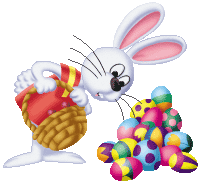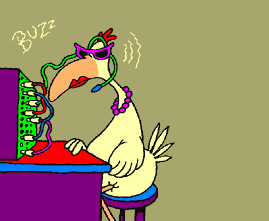|
|
 |
|

History of Easter
In the Christian faith Easter is celebrated to commemorate the
Resurrection of Christ. Thus it is the most sacred of all holy days. Unknown to most people, it is also the name of an ancient
Saxon festival, Easter. Easter is the pagan goddess of spring and offspring. How this pagan festival came to be supplanted
by a solemn Christian holiday attests to the ingenuity of second century Christian missionaries.
These missionaries travelled among the Teutonic tribes north of Rome. Whenever
possible, they transformed local pagan customs to harmonise with Christian doctrine. On a practical basis, this prevented
local converts from being persecuted by the pagan traditionalists. Since the Easter festival to celebrate spring coincided
with the time of the Christian observance of the resurrection of Christ, this crossover was achieved smoothly. Some doubt
remained as to the exact day of the celebration.
Well, back to the Saxons for the Easter bunny. They worshipped the goddess Eastre by the earthly symbol
of a rabbit or "hare" as rabbits were known. Eventually the custom of the Easter bunny was brought to America by the Germans.
Chocolate and Candy eggs have become popular in this century, but exchanging of eggs in
the springtime is an ancient custom. Egyptians buried eggs in their tombs. The Greeks placed eggs on their tombs. A Roman
proverb states, "All life comes from an egg". In most cultures, the egg signifies birth and resurrection. So when the church
began to celebrate the Resurrection in the second century, the egg was a popular symbol. In those days, wealthy people covered
gift eggs in gold leaf, while peasants dyed theirs with flowers and herbs.
Here are a few fun Easter facts:
The Easter bunny was originally called the Easter hare in ancient oriental cultures.
The Easter bunny united with Easter eggs in Germany during their spring celebrations.
In early times, it was believed that the Easter bunny would place colored eggs in nests while the children
were sleeping.
It is a German custom to build a fire the night before Easter so that the Easter bunny can burn wild flowers
to make the dyes to color eggs.
The Easter bunny was believed to be a large bird until the Pagan Goddess of Dawn, named Eostre, changed
him into a rabbit.
In some countries, children play a game where they roll their Easter eggs down a hill.
Over 700 million Marshmallow Peeps are eaten every year at Easter time.

Bless this day the joy of life
Bless this day the joy of life,
The revelation of the flesh,
The paradise of man
and wife
Joined to share the gift of bliss.
Bless this day the pain of life,
The passion that redeems the flesh,
The love between
a man and wife
Beyond all agony and bliss.
Bless this day the end of life,
The peace within the dying flesh,
The bond between
a man and wife
That long outlasts their bit of bliss.
Bless this day the whole of life,
The grace of being more than flesh,
The voyage of a man and wife
Across
the mystery of bliss.
Easter is a time of love
Easter is a time of love,
A time of death and pain undone,
So we may know the power
of
The love that lives in everyone.
Each love we feel, unstained and free,
Redeems us--as with you and me.
Easter comes but once a year
Easter comes but once a year
But when it does, we all know its here
Children
filling themselves with chocolate
Dad's down the pub for a pint of beer!
We go to the church for the wine and bread
Dad's
half asleep, and jerking his head
Baby sister is here too, munching away
On the free easter egg that the Priest gave
us today
But remember we must, that the Lord died for us
And ascended into heaven to give us fresh lives
For
each and every one of us

|
 |
|

EASTER BASKETS AND BUNNIES CUPCAKES:
Prep Time: 45 min. Start to Finish: 2 Hrs. 5 min.
Ingredients:
2 cups sugar
1-3/4 cups all-purpose flour
3/4 cup
Cocoa
1-1/2 teaspoons baking powder
1-1/2 teaspoons baking soda
1 teaspoon salt
2 eggs
1 cup milk
1/2
cup vegetable oil
2 teaspoons vanilla extract
1 cup boiling water
CREAMY VANILLA FROSTING (recipe given above) 3-3/4 cups (10-oz. pkg.) MOUNDS
Sweetened Coconut Flakes, (tinted) * suggested garnishes (marshmallows, liquorice, jelly beans) Preparation: 1. Heat
oven to 350°F. Line muffin cups (2-1/2 inches in diameter) with paper bake cups. 2. In large bowl, stir together sugar, flour,
cocoa, baking powder, baking soda and salt. Add eggs, milk, oil and vanilla; beat on medium speed of electric mixer 2 minutes.
Stir in boiling water (batter will be thin). Fill muffin cups 2/3 full with batter. 3. Bake 22 to 25 minutes or until wooden
pick inserted in centre comes out clean. Cool completely. Prepare CREAMY VANILLA FROSTING; frost cupcakes. Immediately press
desired colour tinted coconut onto each cupcake. Garnish as desired to resemble Easter basket or bunny. About 33 cupcakes.
|
CARROT CAKE
|
|
Ingredients :
3 eggs
1 1/4 cups corn oil
1 1/3
cups packed brown sugar
2 tsp. baking soda
2 tsp. cinnamon
1/2 tsp. salt
2 cups all-purpose flour
1 8-oz. can
crushed pineapple in natural syrup
1/3 cup shredded coconut
1 cup coarsely chopped walnuts
3 cups grated carrots
(about 4 carrots)
|
|
Preparation : |
|
Preheat the oven to 350 degrees. Grease and flour a 13-by-9-by-2-inch pan. In a large
bowl, beat the eggs, oil and brown sugar until well blended. In a separate bowl, sift the baking soda, cinnamon, salt and
flour, then gradually add it to the egg mixture; do not over mix. Add the pineapple and syrup, coconut, walnuts and carrots,
and beat well. Pour the batter into the prepared pan and bake for 45 to 55 minutes, or until a toothpick inserted in the centre
of the cake comes out clean. Cool in the pan for 10 to 15 minutes. Invert onto a cooling rack and cool completely. Serves
12 to 14. |

|
 |
|

'Happy Easter'
'Gelukkige Pasen' - Dutch
« Pâques heureux ' - French
'Glückliches Ostern' - German
"Ευτυχές
Πάσχα" - Greek
'La Pasqua felice ' - Italian
'Glad Østlig' - Norwegian
'Páscoa feliz ' - Portuguese
' Счастливый
Easter' - Russian
'Pascua feliz ' - Spanish
|
 |
 |
 |
|
Some more funny Easter Facts...
The first chocolate eggs were made in Europe
in the early 19th century and remain among the most popular treats associated with Easter.
90 million chocolate Easter bunnies are made
for Easter each year.
16 billion jelly beans are made for Easter.
Each day, five million marshmallow chicks
and bunnies are produced in preparation for Easter.
Easter is the second top-selling confectionery
holiday behind only Halloween.
76 percent of people eat the ears on chocolate
bunnies first.
Red jelly beans are kids' favorite.
According to the Guinness Book of World Records
the largest Easter egg ever made was just over 25-ft high and made of chocolate and marshmallow. The egg weighed 8,968 lbs.
and was supported by an internal steel frame.
The Guinness Book of World Records describes
the largest Easter egg hunt as 8,200 children aged 6-12 searching for 254,000 eggs hidden in Queen Victoria Park in Niagra
Falls.
|
|
 |
 |
 |
|
|
|
|
|

How to make colourful eggs for 'Easter'
To Hard Cook Eggs—Place eggs in saucepan. Add water at least one-inch above the eggs. Cover and bring to a boil. Turn
off heat. Let eggs stand in hot water about 15-17 minutes. Immediately run cold water over the eggs or place in ice water
until completely cooled.
Natural materials can be
used to dye eggs. Experiment with the following substances suggested by the Georgia Egg Commission to obtain beautifully colored
eggs.
Beets* - one bunch sliced for pink
Blackberries - 2 cups frozen and juice for
lavender
Blueberries - 2 cups frozen and juice for blue-gray
Carrot tops* - 1 bunch for light green
Marigolds - petals from 6 gold flowers for
olive green
Onion Skins - from 6 red or yellow for maroon
Red Cabbage* - 2 cups shredded for turquoise
Turmeric - 1 tablespoon powdered spice for
bright yellow
*After cooking with these materials, refrigerate
eggs overnight to deepen color.
To cook and dye eggs at
the same time. Place the uncooked eggs in glass or stainless steel 2 quart saucepan. Add enough water to come to one inch
above eggs. Add one tablespoon vinegar and desired natural material. Cover saucepan and bring to boil; reduce heat and let
simmer 20 minutes. Rinse with cold water and let air dry. Polish eggs with vegetable oil for a vibrant sheen.
To remove shell, crack it
by tapping gently all over. Roll egg between hands to loosen shell, then peel, starting at large end. Hold egg under running
cold water, or dip in bowl of water to help ease off shell.
Do not color or hide
cracked eggs. Hide eggs only in places you can be sure they will remain clean and not come in contact with animal wastes.
Once found, keep eggs refrigerated until eaten, just as you would any perishable food. Hard-cooked eggs should not remain
at room temperature for more than a total of two hours. If they do, it’s best not to eat them, but use them as decorations
only.
The true me
Still a child at heart
|
|
|
 |

